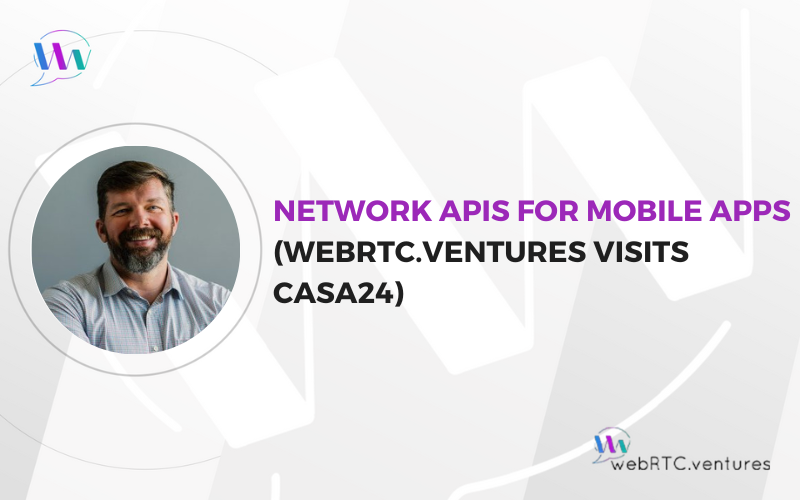What if your mobile app had direct access to data about the telecommunications network it’s running on? What would you do with additional data about things like the quality of your connection, and the device that your application is running on?
I’ve been hearing about the potential power of Network APIs for a while. Since our team at WebRTC.ventures builds web and mobile applications using live video and voice, this is very relevant to our work. With this in mind, I headed to the CASA24 conference in Amsterdam to learn more.
In this blog post, I’ll share a bit of what I learned and what you can expect in the near future from Network APIs. You can see a video about my experience at the conference below, and underneath I’ll go into more depth on my conference takeaways and share a few links to more information.
Let’s start with a little more information about the conference.
CASA24 – Amsterdam, Netherlands – September 16-18, 2024
The CASA24 conference was put on by the CPaaS Acceleration Alliance, a group sponsored by many of the telcos and interested parties who share common interests and goals across their industry.
The CPaaS Alliance gathered its members for its second CPaaS Acceleration Summit in Amsterdam (CASA). Various topics were on the agenda, including Network APIs, AI in telecom, and Customer Experience (CX) in communication applications. Due to travel constraints, I was only able to attend one day, which primarily focused on CX and AI. However, I still had the opportunity to speak with many attendees about the ongoing discussions around Network APIs.
A Side Note on CPaaS
As a reminder, a CPaaS is a cloud-based Communications Platform as a Service, and refers to any type of communications service that is made available via relatively simple APIs. A CPaaS enables developers to build communication applications without an in-depth understanding of telco standards.
In the context of our work at WebRTC.ventures, a CPaaS is typically providing a commercial API to things like media servers for WebRTC-based video, voice, and chat applications. The benefit of using a CPaaS is that it may be faster to build and scale your application, since the CPaaS handles all aspects of the media server scaling for you.
While a CPaaS typically offers a more straightforward integration, it often comes with higher transaction costs compared to open source alternatives. Open source media servers, on the other hand, provide greater flexibility and lower transaction costs but usually involve higher upfront development expenses and demand more DevOps expertise to scale effectively. Choosing between a CPaaS or an open source solution depends on your specific needs. At WebRTC.ventures, our team is highly experienced in both CPaaS and open source implementations and can help you determine the best fit for your situation.
What is a Network API?
Network APIs are being discussed a lot in telco circles right now, along with topics like 5G, 6G, IP Multimedia Subsystems (IMS), and 5G New Calling. All of these topics promise to bring more interactivity to mobile phone networks, and the telcos are interested in making a lot of these new capabilities available to software developers via APIs.
Network APIs specifically will create ways for software developers to learn more about the particular mobile network connection their application is using at any given time. As a mobile user moves around, they will get switched between different network endpoints, and may even switch network carriers, as they move through a city or region.
For normal phone users, these things all happen seamlessly and don’t interrupt normal voice calls or data connectivity for mobile apps. But if you’re transferring a lot of data over the cellular network, exchanging important real-time data, or building a video application using the WebRTC standard like our team does, those network changes can affect the performance of the application or even cause the connection to fail.
In the past, web developers did not have access to much network information. The typical web or mobile app treats the mobile network it’s running on like any other internet connection, and just assumes (hopes!) that the connection is going to stay open and have the necessary bandwidth. Because WebRTC developers know this isn’t reality, we build in things like call reconnects and video quality degradation into our applications and use testing techniques like network throttling in order to give users the best possible experience in any network condition.
Network APIs may help us to address those problems, or at least better act on them. They offer other benefits, too. Let’s start by looking at some of the potential use cases for Network APIs.
Use Cases for Network APIs
At the CASA24 conference, I asked several people to give me their pitch as to why Network APIs will be important to developers like us. More importantly, I asked what benefits our applications can offer its users once we implement Network APIs into our code.
Here’s the most common answers that I received:
- Monitoring Network Quality. If you’re able to know more about the quality of the connection you are on, then your video communications app can be more proactive about things like downgrading video quality so the call doesn’t drop, warning users about the strength of their connections, or muting their video temporarily in order to preserve audio quality. WebRTC developers do these things now using various types of bandwidth checks, but Network APIs should offer more reliable ways to measure the connection quality.
- Network Slicing for Performance. Some types of mobile traffic are more important than others. Industry Analyst Dean Bubley spoke at CASA24 and gave the example of a drone operator operating their device over a mobile network. They don’t care about the details of that network; they just don’t want their drone to fall out of the sky because it lost connectivity! Using Network APIs, the data or streaming video traffic from that drone could be given a different slice in the network, to ensure it arrives when it’s needed and that the drone stays in the air.
- Identify Verification. This is the use case most people talked about. Think about how 2-Factor Authentication (2FA) works in mobile apps now. You open your banking application on web or mobile and it sends you a numeric code via an SMS text message to confirm that you have access to the phone number tied to your account. While effective, this form of 2FA creates extra clicks that slow users down. With Network APIs, you could perform 2FA in a mobile app without a text message because the network carrier already knows the device being used and who owns it.
- Know Your Customer (KYC) regulations. For FinTech applications, it’s particularly important to verify identity when someone is opening a bank account. Similar to the above description of 2FA using Network APIs, you can have more assurance who the person is that you’re speaking to. These could even be used for things like Age Verification to confirm that the person who owns that device is an adult and allowed to access a website or purchase products.
The CAMARA Standard
There are MANY different telecommunications networks around the world. It would be a nightmare if they all used their own API definitions or if they didn’t return consistent types of data. The industry understands that and have converged around a standard called CAMARA.
CAMARA is “an open source project within Linux Foundation to define, develop and test the APIs.” Its goal is to simplify existing Network APIs and provide simple interfaces that developers can use across different countries and telco networks seamlessly.
Successful completion of this project will be crucial to the ultimate success of the ideas described above. While it’s not clear how long this process will take, it is a good sign that it is backed by major operators like Verizon, Ericsson, T-Mobile, Nokia, and Telefónica.
Challenges remain
While most people I talked with at CASA24 were optimistic about the ultimate success of Network APIs, there are some valid concerns remaining in the CPaaS, WebRTC, and communications community.
- Not all Network APIs are done. And what is done is not widely available to developers yet. Until things are more widely accessible to developers outside of the big telcos, it’s going to be hard to drive adoption.
- Developer Relations. As one speaker noted, “you can’t just build an API and they will come.” The telco community and the networks are going to need to do some hard work to get the broader tech community and mobile app developers excited about the use cases and features that this opens up to them for their apps.
More Architectural Choices for Communications Developers!
While it may take some time for things to fully materialize, the trend is clear: mobile app developers can look forward to gaining more insight into the networks their apps run on, which will open up interesting new architectural possibilities.
Of course, there’s no need to wait to build your communications application! Our team at WebRTC.ventures are experts in the leading CPaaS platforms and open source media servers. Whether your application uses Video, Voice, or integrates with traditional telephone and VoIP in contact centers, we can help. Contact us today!











